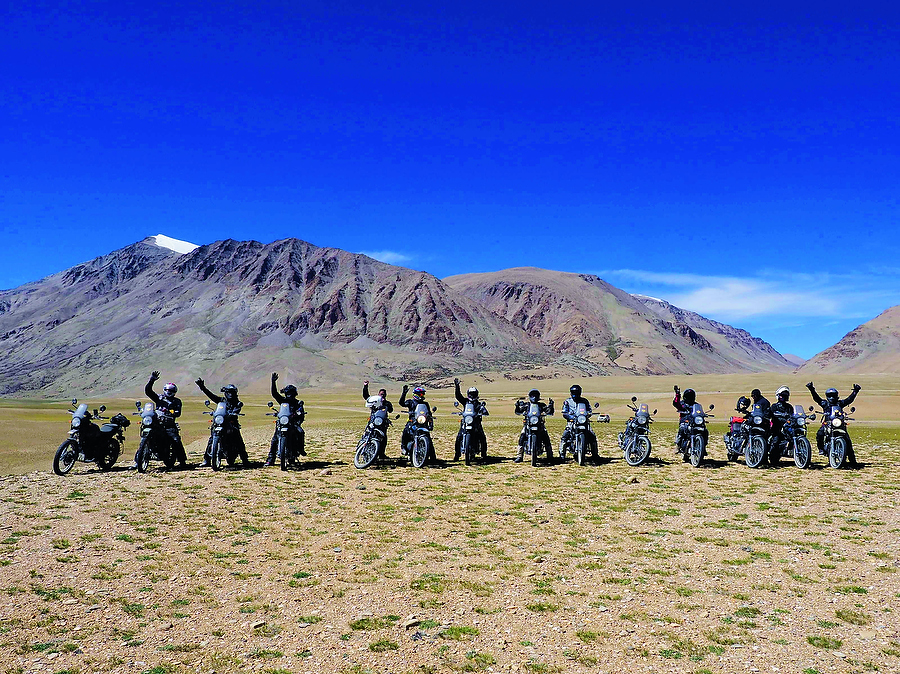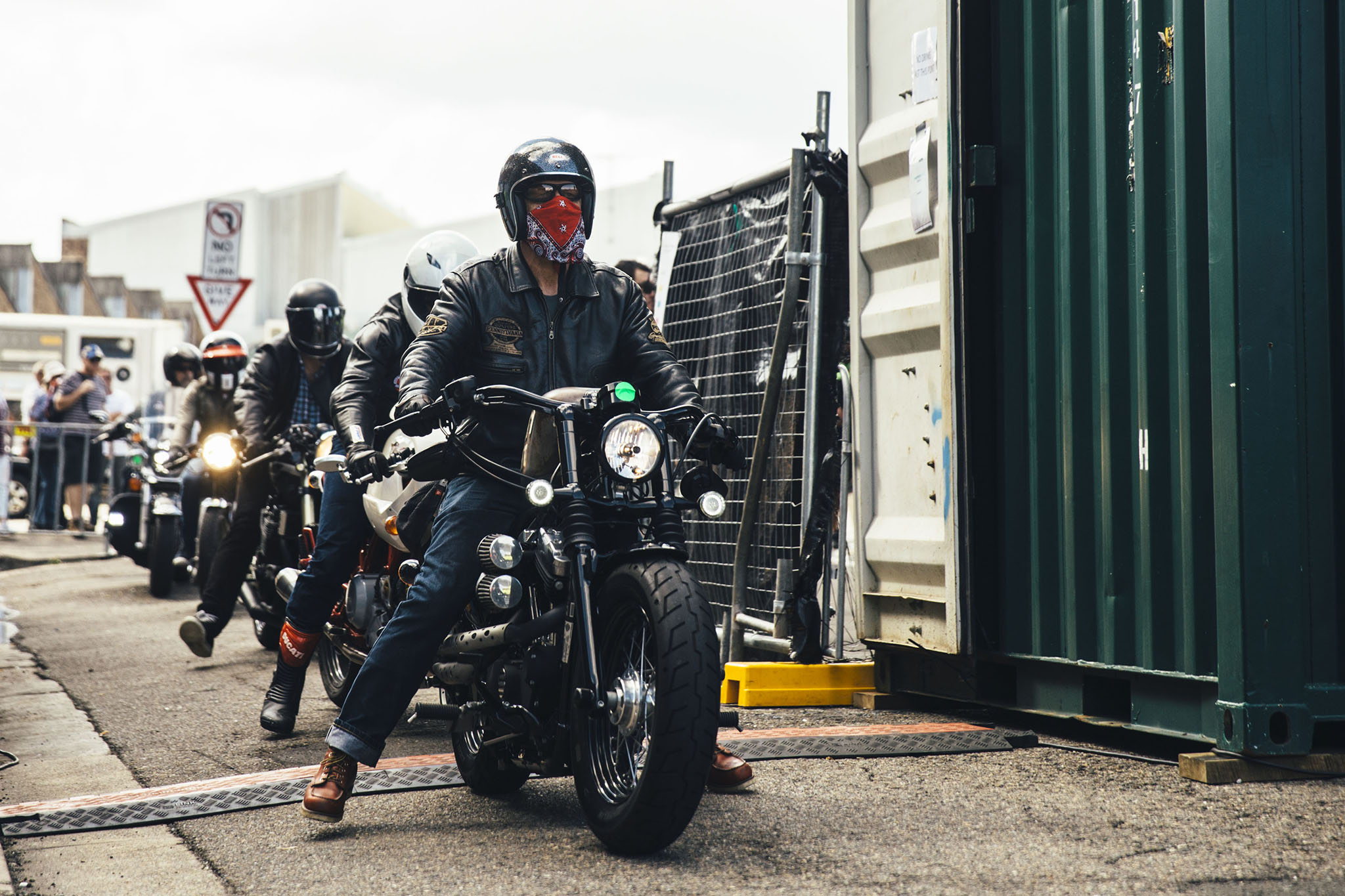
The mountains on the motorcycle, both named Himalayan, where altitude, isolation and adventure meet.
DUST, ROCKS AND ROADS
After a few days of air travel, acclimatisation and riding in the Himalayan mountains, we started heading out across tougher terrain. Our hosts, Moto Himalayan, didn’t simply take us on a looping ride around the districts, but planned visits to spectacular locations via incredible roads.
There were the rides over three major passes (Khardung La, Chang La and Taglang La), each one offering tougher conditions than the previous. Khardung La is close to Leh and has become so popular that it’s at the top of a well-sealed and often quite wide bitumen road… but you still need to have your wits about you because it does get narrow near the edge and oncoming trucks can invade your side of the road, so keep left.
The scenery at the pass is good, but stop along the way to take in the spectacular views of Leh and then the valleys and mountains as you climb higher. Don’t stay too long at the top or you risk altitude sickness, especially if you climb the stairs to the thousands of prayer flags.
The lack of oxygen saps your strength and I’m sure it makes it harder to concentrate on your riding, so take it easy.

Many tourists turn around and go back down the mountain from Khardung La, but our adventure continued on to Nubra, where we stayed in glamping tents complete with proper beds and basic bathrooms. The views are even more spectacular on the far side of Khardung La, with mountains stretching across the horizon and the road winding its way up and down the side of the hills.

Coming into the Nubra Valley, we saw it was filled with vegetation where there weren’t sand dunes. It’s a wide valley that would have a lot of water flowing through it during the winter. The settlement actually has some booze available (not cold, though, as power is only available from a generator which runs for a few hours each evening) and a dining room for the standard buffet-style evening meal, in this case totally vegetarian.
There was an offer to “go see the camels”, which all of the Australians declined. If they had said “want to go for a camel ride” the answer may have been different, but something got lost in the translation and I’m a bit jealous of the Indonesians who got to ride the smelly beasts. They looked like they enjoyed themselves.
I was flying my drone, getting some shots through to sunset as the sky changed colour and reflected off the water, with the valley floor in the distance. A drone in these regions is both fabulous and awful as I constantly felt like I was missing out on shots as I didn’t have the time or the battery life to be putting it into the air every time we stopped. And there were numerous stories of people getting in serious trouble for flying their drones in the region — the army hates it. Do so near one of their bases and expect a visit. And if you do take one, pack it in your luggage, not in your carry-on. I got into trouble for this, twice… in Australia they wanted me to take it in hand luggage, but not in India.

Water influences everything in the Himalayas. The area gets plenty of snow, but not rain, so settlements are along rivers where the locals can scratch a living out of agriculture using river and lake water. Tourists, of course, want long, hot showers, but this puts a lot of strain on local resources, so don’t do it! A quick wash with a bucket is all you’ll get sometimes.
The rivers really influence the tours too, because that’s where many of the roads go — beside the rivers to join the townships. These rivers are fed by snowmelt, starting out as creeks and streams at high altitudes and turning into raging rivers at lower altitudes. We crossed hundreds of bridges and many shallow water crossings, even a handful of deeper ones, all the while being told that having come in late August, the crossings were shallow and easy.

If you want a hard-core Himalayan adventure, go at the start of the season when the weather is colder and less predictable, the rivers are flowing higher and faster and there’s a greater chance of rain. Me, I was happy riding in the balmy humidity-free conditions and mild temperatures we experienced at the higher altitudes while wishing for air-conditioning in the hotel in Leh.
CHANG LA
At just under 5400m, Chang La is one of the world’s highest passes, but you’d hardly have known it the day we visited. There were people everywhere, despite recommendations you stop, take a few pictures and keep going in order to avoid altitude sickness.
The road to get there, Pangong Lake Road, is rough, slippery and covered in switchbacks as it climbs the mountain to Chang La. It’s also built for army trucks, tourist busses and Royal E nfield bullets, so it can be traversed by anything, but travel is slow…
Late August would also be peak tourist season, so the roadside stalls were humming and cameras clicking (OK, so they were phones making fake shutter sounds). Getting there had the Himalayans struggling for power — 5000m is hard on engines as they fight to breathe. Going down the other side was possibly worse though; the road is rough and there aren’t any barriers to prevent deadly trips down the side of the mountains…
But views from Chang La are spectacular, making it well worth the ride beyond “I did it”. Snow-capped mountains close by and a view down the valley — to the rough road we’d take towards Leh — greeted us from the pass. Some of the roads we experienced had the 400cc Himalayans tapped-out as we worked the gearboxes and searched for more speed, but this wasn’t common; rather, we’d likely be standing on our footpegs, letting the rock-strewn gravel move the bike around beneath us as we negotiated the loose surfaces.
Sometimes there were no real roads at all, the bitumen having been washed away by an earlier weather event. A number of our crew took small tumbles in the soft stuff… with one crash more serious, resulting in a broken leg.

THE DOC, THE GAMOW BAG AND HEADACHES
Our doctor for the trip, a smart man named Wangchuk, got our unfortunate Indonesian friend to a medical facility quickly and a broken leg was diagnosed soon after the X-ray. He was going home, with Moto Himalayan getting him into one of the support vehicles and back down to Leh where he could fly out to Jakarta via New Delhi without delay. It was the only bike injury Wangchuk needed to treat on the tour, but he was a busy man anyway.
The biggest problem was altitude sickness, which manifests itself in many ways. I copped a nasty headache one night that was treated simply with paracetamol after Wangchuk checked my pulse and blood oxygen level. Others weren’t so lucky, requiring oxygen from the cylinders carried by Moto Himalaya.
As a last resort, and something demonstrated on a couple of the guys who were struggling with the altitude, the Gamow Bag was called upon. A thick vinyl bag shaped like a giant sleeping bag, the Gamow Bag is pumped up after someone slides inside. The resulting air pressure is the equivalent of taking them down the mountain a couple of thousand metres. The two men who tried it out loved the experience and it was a reminder of why there are big advantages to joining a tour of the Himalayas rather than simply hiring a bike and heading out.
 CRICKET, THE ENVIRONMENT AND HEADING HOME
CRICKET, THE ENVIRONMENT AND HEADING HOME
Early in the tour I asked Jitin, one of our guides, about the lack of vegetation on the hills. “We’re too high,” he told me. “This area can easily be under 20 feet of snow in the winter and when the snow melts, it doesn’t leave anything vegetation can grow in.” Basically the only vegetation you’ll see is in the valleys and a little by the lakes.
“Global warming is damaging the land here,” Jitin explained. “It would hardly ever rain in the old days — it was either dry or it would snow. Nowadays we get a lot more rain and that’s causing landslides and changing the environment.”
I can’t say how much it has changed over the years, but I do know it’s spectacular. Every day offered amazing views and experiences, but it was during our last day on the road when something unexpected happened. In the thin air at 5000m, my drone was struggling to climb to capture some of the scenery of Tso Kar lake when I heard the unmistakeable sound of willow on leather. OK, it was probably a synthetic ball and the bat was a cheapie that had seen better days, but in an area where many people struggle to breathe, cricket was being played.
Pretty soon it was Australia versus India, and despite the best efforts of the tourists, we were roundly trounced. The locals, our tour group leaders and support team were not just cricket tragics, they were also younger, better skilled and fitter…
I didn’t come to the Himalayas to play cricket, but I’m kinda shocked I was able to. And it’s the unexpected that often makes a trip memorable; being able to capture a photo of a local’s Royal Enfield Bullet with a cricket match and the Himalayas in the background? Priceless.
TANGLANG LA
Our final pass was Tanglang La, which lies on what passes for the main road from the flatlands off the Himalayas to Leh. It was a relatively short ride to the main road and from there it was up the hill to Tanglang La, a short stop for some pictures, and then we kinda gave the Himalayans their heads… dropping from over 5300m to Leh at 3500m in just over 100km on a wider, smoother and simply better road than we’d seen since leaving Australia… well, some of us probably rode a little quicker than we should have.
My excuse was I was always trying to catch up after stopping to shoot more photos. The fact the road was filled with numerous switchbacks and was actually wide enough to have a dividing line meant we were less worried about head-on collisions. I stopped a few times on that ride, mostly for pictures, and I should have stopped for more as the road followed a river which had carved a path through the mountains to create its own valley.
There was one unexpected stop, just out of Leh, where the bike started to wobble around and I knew I had a flat rear tyre. When the support truck arrived they simply switched-out the wheel… faster and simpler than trying to replace tubes in the field.
We were soon back in Leh, to civilisation and hot showers. A day later and it was on a plane to New Delhi, where I spent an afternoon exploring one of the busiest, most chaotic places I’ve ever seen, then more planes home.
The Himalayas has been on my bucket list of places to visit for decades, and to be able to do it on a motorcycle will live with me forever. Barren, remote, spectacular and amazing.














